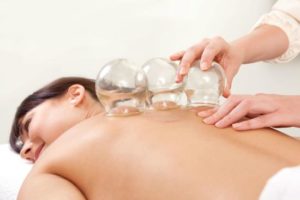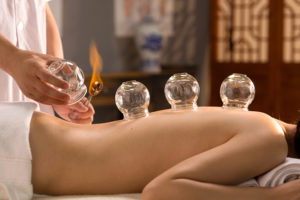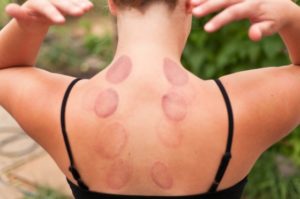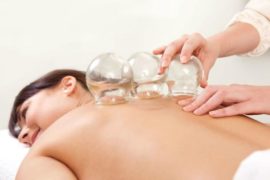What is Cupping?

Cupping is a Chinese alternative medicine in which cups are applied to your skin to break up stagnant blood and a poor energy flow. There is wet and dry cupping. Dry cupping is just applying the cup to your skin, but with wet cupping, you are pricked with a needle before suction. Practitioners believe that by pricking your skin with a needle prior to cupping, you help release toxins from the body. Many of the photos we see of the cups used in cupping are glass cups. But they are not the only cups used. There are bamboo, silicone and plastic cups that are also used. In some instances, acupuncturists will insert a needle into an acupoints and then suction the cup over top of it.
While today the cupping is mostly created by using a rubber pump, many practitioners use flammable substances such as alcohol, herbs, or paper in a cup and they’ll set it on fire. While the fire is beginning to fade, the practitioner will place the cup upside down on your skin so that your skin will rise and redden. Your practitioner would either leave the cup stagnant, or they could use massage oils to move the cups around.
What are the Benefits of Cupping?

While the studies that have been done for cupping aren’t strong enough to prove beneficial, practitioners believe that cupping can:
- Calm your nervous system
- Provide relaxation
- Loosens restrictions in the tissues
- Improving blood flow
- Reduce inflammation
- Helps to optimize athletic performance
What is Cupping Used For?

Just as the benefits of cupping still need to be proved, research studies for conditions that cupping can be used to treat still need stronger studies to be completed to fully prove its effectiveness. According to the British Cupping Society, these are conditions that cupping can help treat:
- Fertility
- High blood pressure
- Headaches
- Anxiety / Depression
- Bronchial congestion
- Rheumatic diseases
- Skin problems
- Digestive issues
When You Should Avoid Cupping

Woman who are pregnant should not try cupping, along with people with blood pressure problems. If your skin is broken, irritated, or inflamed, you should avoid cupping in those areas. Children and older adults should also not participate in cupping. If you have any health conditions such as cancer, organ failure, blood disorders, or heart diseases, you should avoid cupping, as well.
Side Effects

As with most treatments, there are side effects. While you are expected to have bruises and marks after a treatment, this may sometimes cause a scar or burns. Other possible side effects are:
- Pain
- Swelling
- Dizziness
- Nausea
- Fainting
- Sweating
- Lightheadedness
Make sure that after your cupping procedure your practitioner covers the areas with an ointment and bandages to prevent infection.
Celebrities Who Love Cupping
Gwyneth Paltrow

Paltrow was seen in 2004 at an event with cupping marks all over her back.
Jennifer Aniston

In 2003, Aniston was seen with some cupping marks on her back at an event with then fiancé, Justin Theroux.
Kim Kardashian West

Kardashian shared on the app, Snapchat, that she was using cupping to help relieve neck pain.
Michael Phelps

At the 2016 Olympics, Phelps debuted cupping marks all over his body.
References:
Cupping Therapy. WebMD.
Hoff, V. 2018. Here’s What to Expect the First Time You Get Cupping. The Thirty.
Rushall, K. 2017. The Many Benefits of Chinese Cupping. Pacific College of Oriental Medicine.
Daly, A. 2018. What Is Cupping Therapy – And Should You Try It? Women’s Health.
Wong, C. 2018. What is Cupping Therapy? Very Well Health.
Marcin, A. 2019. What is Cupping Therapy? Health Line.
Khatib, H. 2016. 9 Celebrities Who are Into Cupping. Elle.
Knowlton, E. 2016. Why Michael Phelps and Other Olympians Have Big Red Circles All Over Their Skin. Business Insider.
Feller, A. 2018. Cupping Marks Have Become a Wellness Badge of Honor. Well Good.

